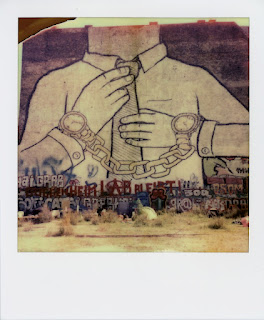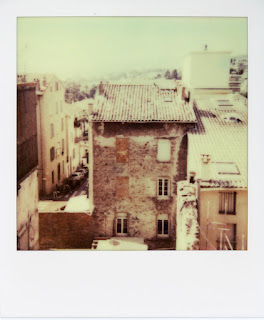Now that summer is wrapping up, I’m also wrapping up my summer projects. I have just added a new set of Polaroids to my site, entitled “Occupying Spaces”, a photo documentation of sorts of occupied places in Berlin.
Occupying public, or indeed private, spaces has had a long history in Berlin. During the time of the Berlin Wall, at a time when living space was limited in West Berlin, many real estate developers let apartment building stand empty in order to get permission to tear the rotting buildings down and build new ones. Many, if not most, of these buildings ended up being occupied by squatters. Similarly, another phenomenon occurred on unused (or disused) public terrain: squatters used them to set up camp, living in trucks, sheds and mobile homes. As they fortified the camps against possible raids by the city authorities, these settlements became known under the Wild West term of “corral” (“Wagenburg” in German).
When the Wall came down, squatting bloomed briefly in East Berlin as well as people found more disused buildings to occupy, but in the 1990s, with Berlin being again the German capital, most of these buildings were cleared, often in violent confrontations between the occupiers and the police (or the government came to an arrangement with the occupiers who’d eventually became owners of the buildings); and most of the “corrals” were cleared as well,
However, that whole “cleaning up the city” act by the city government does not mean that there are no more occupied spaces today. There are still a few corrals left here and there; and a couple of squatted apartment blocks also remain. Additionally, a number of old factories and warehouses along the Spree river which are left to rot as developers are seeking permission to tear these old buildings down and erect shiny new office palaces on the much-priced water front, have now been occupied by squatters who live there, artists who work there, or modern day nomads from all over Europe who come to stay there for a while. And, it has to be said, by trigger happy tourists who have read about these places in the latest tourist guides….

Then there is the curious case of Osman Kalin’s tree house. Mr. Kalin, a Turkish immigrant, set up a garden and tree house on a patch of land that technically belonged to East Germany but was located on the Western side of the Wall. During the separation of the halves of the city, he was left alone by both authorities, but after the Wall came down, pressure was put upon him to tear down the tree house. Mr. Kalin persisted… and lives there still.
Unused areas along the river also became the site for a good number of improvised beach bars - now unfortunately getting replaced by commercial venues as Berliners' fondness for sipping beer and cocktails by the river has been established.
Yet another now popular past time is for local residents to set up improvised gardens, playgrounds and even pet zoos in patches of unused and/or unclaimed land.
In other words, Berliners are still busy (re-)claiming their city from what they perceive as willful negligence by those trying to make a quick buck out of… doing nothing.
As one of my summer projects, I tried to document these “occupied spaces” with the Polaroid cameras. I visited occupied factories and derelict buildings, a couple of the remaining “corrals”, improvised “beaches” and camp sites.
There are a couple of remarks I should add. One is that, as you can see, graffiti plays a big role in occupying these spaces – as indeed it represents a ‘marking of the territory’. As such, I extended the scope of the photo selection to also include random, interesting graffiti around the city not necessarily linked to occupied places.
As to the “corrals”: the inhabitants of these camps are notoriously private and averse to visitors, especially those carrying cameras. For a good reason: since some of the tourist guide books have started “featuring” them, the corrals have become tourist attractions of their own. Thus, while I photographed the surrounding “public” areas (taken up by mostly by graffiti and art work), I did not manage to get any photos taken inside the camps proper, which I find too bad.
I used primarily a couple of Polaroid SX-70 cameras with a variety of Impossible Project films, including the new “color protection” film.
In a few instances I also used the Fuji Instax 210 camera, and I added an additional gallery with only the instax photos on urban art.
Links:







.jpg)
